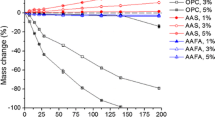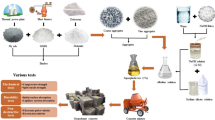Abstract
Natural pozzolanas should be evaluated in terms of sustainability as well as their contribution to concrete durability. Therefore, the use of such materials in the production of cement as well as concrete industry has been gaining importance recently. In this study, the pozzolanic activities of ground trachyte and rhyolite, known as volcanic tuffs, were investigated in accordance with TS 25 standard. Pozzolanic properties of such materials, along with their pozzolanic activity indices, are investigated comparatively by the Frattini method, strength activity index, X-ray diffraction and thermogravimetric analysis. The morphologies of ground trachyte and rhyolite were also studied using SEM analysis. Based on the results obtained, the mortar samples containing blast furnace slag (BFS), fly ash (FA), trachyte and rhyolite were met the acceptable pozzolanic activity index at the end of 28 days with values of 90, 87, 89, 87, respectively. On the other hand at the end of 90 days, while the mortar samples containing BFS, FA and trachyte were met the acceptable pozzolanic activity index, that of containing rhyolite did not meet the acceptable pozzolanic activity index, with values of 93, 85, 87, 80, respectively. The pozzolanic activity index of the rhyolite was found to be quite close to that of the FA; however, the trachyte had a pozzolanic activity index close to the BFS. Comparisons of the methods implemented in the analyses were also conducted. According to the statistical evaluation of the test methods, it has been found that the relationships obtained using the direct methods as well as the indirect methods independently are highly correlated. Overall, it can be concluded that the ground trachyte may be utilized as a pozzolanas in the cement industry; however, the ground rhyolite does not meet some limits prescribed by the related standard.













Similar content being viewed by others
References
Chelsea Harvey (2018) Cement producers are developing a plan to reduce CO2 emissions. E&E News. https://www.scientificamerican.com/article/cement-producers-are-developing-a-plan-to-reduce-co2-emissions/. Accessed 7 Jan 2019
Massazza F (2001) Pozzolana and pozzolanic cements. Lea’s Chemistry of Cement and Concrete, Arnold
Merzouki T, Bauasker M, Khalifa NEH, Mounanga P (2013) Contribution to the modeling of hydration and chemical shrinkage of slag blended cement at early. Constr Build Mater 44:368–380. https://doi.org/10.1016/j.conbuildmat.2013.02.022
Abbas S, Kazmi SMS, Munir MJ (2017) Potential of rice husk ash for mitigating the alkali-silica reaction in mortar bars incorporating reactive aggregates. Constr Build Mater 132:61–70. https://doi.org/10.1016/j.conbuildmat.2016.11.126
Nayır S, Erdogdu Ş, Kurbetci Ş (2017) Effectiveness of mineral additives in mitigating alkali-silica reaction in mortar. Comput Concr 20:705–710. https://doi.org/10.12989/cac.2017.20.6.705
Dezfouli HR, Afshinnia K, Rangaraju PR (2018) Efficiency of ground glass fiber as a cementitious material, in mitigation of alkali-silica reaction of glass aggregates in mortars and concrete. J Build Eng 15:171–180. https://doi.org/10.1016/j.jobe.2017.11.018
Wang D, Zhou X, Meng Y, Chen Z (2017) Durability of concrete containing fly ash and silica fume against combined freezing-thawing and sulfate attract. Constr Build Mater 147:398–406. https://doi.org/10.1016/j.conbuildmat.2017.04.172
Huang H, Gao X, Wang H, Ye H (2017) Influence of rice husk ash on strength and permeability of ultra-high-performance concrete. Constr Build Mater 149:621–628. https://doi.org/10.1016/j.conbuildmat.2017.05.155
Younes MM, Abdel-Rahman HA, Khattab MM (2018) Utilization of rice husk ash and waste glass in the production of ternary blended cement mortar composites. J Build Eng 20:42–50. https://doi.org/10.1016/j.jobe.2018.07.001
Rajasekar A, Arunachalam K, Kottaisamy M, Saraswathy V (2018) Durability characteristic of ultra-high strength concrete with treated sugarcane bagasse ash. Constr Build Mater 171:350–356. https://doi.org/10.1016/j.conbuildmat.2018.03.140
Meddah MS, Ismail MA, El-Gamal S, Fitriani H (2018) Performance evaluation of binary concrete designed with silica fume and metakaolin. Constr Build Mater 166:400–412. https://doi.org/10.1016/j.conbuildmat.2018.01.138
Meyer C (2009) The greening of the concrete industry. Cem Concr Compos 31(8):601–605. https://doi.org/10.1016/j.cemconcomp.2008.12.010
Değirmenci FN (2018) Utilization of natural and waste pozzolans as an alternative resource of geopolymer mortar. Int J Civ Eng 16:179–188. https://doi.org/10.1007/s40999-016-0115-1
Davraz M, Ceylan H, Topçu İB, Uygunoğlu T (2018) Pozzolanic effect of andesite waste powder on mechanical properties of high strength concrete. Constr Build Mater 165:494–503. https://doi.org/10.1016/j.conbuildmat.2018.01.043
Uzal B, Turanlı L, Göncüoğlu MC, Çulfaz A (2010) Pozzolanic activity of clinoptilolite: a comparative study with silica fume, fly ash and a non-zeolitic natural pozzolan. Cem Concr Res 40(3):398–404. https://doi.org/10.1016/j.cemconres.2009.10.016
Khodabakhshian A, Brito JD, Ghalehnovi M, Shamsabadi EA (2018) Mechanical, environmental, and economic performance of structural concrete containing silica fume and marble industry waste powder. Constr Build Mater 169:237–251. https://doi.org/10.1016/j.conbuildmat.2018.02.192
Ergün A (2011) Effect of the usage of diatomite and waste marble powder as partial replacement of cement on the mechanical properties of concrete. Constr Build Mater 25(2):806–812. https://doi.org/10.1016/j.conbuildmat.2010.07.002
Karim MR, Hashim H, Razak HA (2016) Assessment of pozzolanic activity of palm oil clinker powder. Constr Build Mater 127:335–343. https://doi.org/10.1016/j.conbuildmat.2016.10.002
Cordeiro GC, Tavares LM, Toledo Filho RD (2016) Improved pozzolanic activity of sugar cane bagasse ash by selective grinding and classification. Cem Concr Res 59:269–275. https://doi.org/10.1016/j.cemconres.2016.08.020
Ustabas İ, Kaya A (2018) Comparing the pozzolanic activity properties of obsidian to those of fly ash and blast furnace. Constr Build Mater 164:297–307. https://doi.org/10.1016/j.conbuildmat.2017.12.185
Abdelli K, Tahlaiti M, Belarbi R, Oudjit MN (2017) Influence of the pozzolanic reactivity of the blast furnace slag (BFS) and metakaolin on mortars. Energy Proc 139:224–229. https://doi.org/10.1016/j.egypro.2017.11.200
Tüfekçi MM, Çakır Ö (2017) An investigation on mechanical and physical properties of recycled coarse aggregate (RCA) concrete with GGBFS. Int J Civ Eng 15(4):549–563. https://doi.org/10.1007/s40999-017-0167-x
Özcan A, Karakoç MB (2019) The resistance of blast furnace slag-and ferrochrome slag-based geopolymer concrete against acid attack. Int J Civ Eng 17:1571–1583. https://doi.org/10.1007/s40999-019-00425-2
Nguyen CV, Lambert P, Bui VN (2020) Effect of locally sourced pozzolan on corrosion resistance of steel in reinforced concrete beams. Int J Civ Eng. https://doi.org/10.1007/s40999-019-00492-5
Donatello S, Tyrer M, Cheeseman CR (2010) Comparison of test methods to assess pozzolanic activity. Cem Concr Compos 32(2):121–127. https://doi.org/10.1016/j.cemconcomp.2009.10.008
TS 25 (2008) Natural pozzolan (trass) for use in cement and concrete- definitions, requirements and conformity criteria. Turkish Standards Institute, Ankara
BS EN 196-5 (2011) Methods of testing cement, pozzolanicity test for pozzolanic cement. British Standards Institution, London
BS EN 197-1 (2011) Cement composition, specifications and conformity criteria for common cements. British Standards Institution, London
Loukili A, Khelidj A, Richard P (1999) Hydration kinetics, change of relative humidity and autogenous shrinkage of ultra-high strength concrete. Cem Concr Res 29:577–584. https://doi.org/10.1016/S0008-8846(99)00022-8
Hamidi M, Kacimi L, Cyr M, Clastres P (2013) Evaluation and improvement of pozzolanic activity of andesite for its use in eco-efficient cement. Constr Build Mater 47:1268–1277. https://doi.org/10.1016/j.conbuildmat.2013.06.013
Arora A, Sant G, Neithalath N (2016) Ternary blends containing slag and interground/blended limestone: hydration, strength, and pore structure. Constr Build Mater 102:113–124. https://doi.org/10.1016/j.conbuildmat.2015.10.179
Monteagudo M, Moragues A, Galvez JC, Casati MJ, Reyes E (2014) The degree of hydration assessment of blended cement paste by different thermal and thermogravimetric analysis. Morphological evolution of the solid phase. Thermochim Acta 592:37–51. https://doi.org/10.1016/j.tca.2014.08.008
Khalil NM, Hassan EM, Shakdofa MME, Farahat M (2014) Beneficiation of the huge waste quantities of barley and rice husks as well as coal fly ashes as additives for portland cement. J Ind Eng Chem 20(5):2998–3008. https://doi.org/10.1016/j.jiec.2013.11.034
Uchima JS, Restrepo OJ, Tobon JI (2015) Pozzolanicity of the material obtained in the simultaneous calcination of biomass and kaolinitic clay. Constr Build Mater 95:414–420. https://doi.org/10.1016/j.conbuildmat.2015.07.104
Sow M, Hot J, Tribout C, Cyr M (2015) Characterization of spreader stoker coal fly ashes (SSCFA) for their use in cement-based applications. Fuel 162:224–233. https://doi.org/10.1016/j.fuel.2015.09.017
Cyr M, Husson B, Carles-Gibergues A (1998) Détermination, par diffraction des rayons X, de la teneur en phase amorphe de certains matériaux minéraux. J Phys IV 8(5):23–30. https://doi.org/10.1051/jp4:19985
Hewlett PC (2001) Lea’s chemistry of cement and concrete. Butterworth Heinemann, Oxford
Lothenbach B, Scrivener K, Hooton RD (2011) Supplementary cementitious materials. Cem Concr Res 41(12):1244–1256. https://doi.org/10.1016/j.cemconres.2010.12.001
BS EN 196-1 (2016) Methods of testing cement determination of strength. British Standards Institution, London
BS EN 450-1 (2012) Fly ash for concrete. Definition, specifications and conformity criteria. British Standards Institution, London
Deboucha W, Oudjit MN, Bouzid A, Belegraa L (2015) Effect of incorporating blast furnace slag and natural pozzolana on compressive strength and capillary water absorption of concrete. Proc Eng 108:254–261. https://doi.org/10.1016/j.proeng.2015.06.145
ASTM C618-19 (2010) Standard specification for coal fly ash and raw or calcined natural pozzolan for use in concrete. ASTM International, West Conshohocken
BS EN 15167-1 (2006) Ground granulated blast furnace slag for use in concrete, mortar and grout. Definitions, specifications and conformity criteria. British Standards Institution, London
Ezziane K, Bougara A, Kadri A, Khelafi H, Kadri E (2007) Compressive strength of mortar containing natural pozzolan under various curing temperature. Cem Concr Compos 29(8):587–593. https://doi.org/10.1016/j.cemconcomp.2007.03.002
Shon CS, Kim YS (2013) Evaluation of West Texas natural zeolite as an alternative of ASTM class F fly ash. Constr Build Mater 47:389–396. https://doi.org/10.1016/j.conbuildmat.2013.04.041
BS EN 1015-3 (1999) Methods of test for mortar for masonry—part 3: determination of consistence of fresh mortar (by flow table). British Standards Institution, London
Author information
Authors and Affiliations
Corresponding author
Rights and permissions
About this article
Cite this article
Baki, V.A., Nayır, S., Erdoğdu, Ş. et al. Determination of the Pozzolanic Activities of Trachyte and Rhyolite and Comparison of the Test Methods Implemented. Int J Civ Eng 18, 1053–1066 (2020). https://doi.org/10.1007/s40999-020-00516-5
Received:
Revised:
Accepted:
Published:
Issue Date:
DOI: https://doi.org/10.1007/s40999-020-00516-5




